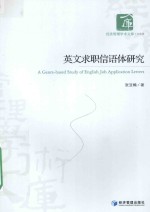

英文求职信语体研究PDF电子书下载
- 电子书积分:9 积分如何计算积分?
- 作 者:张亚楠著
- 出 版 社:北京:经济管理出版社
- 出版年份:2014
- ISBN:9787509633243
- 页数:181 页
Introduction 1
0.1 Research Background 1
0.2 Research Questions 2
0.3 Purpose and Significance 2
0.4 Methodology 3
0.5 Organization of the Book 4
Chapter1 Literature Review 6
1.1 Definitions of Genre 7
1.1.1 Systemic-Functional Perspective 7
1.1.2 ESP Perspective 7
1.1.3 New Rhetoric Perspective 9
1.2 Previous Studies on Job Application Letters 9
1.2.1 Related Studies Abroad 10
1.2.2 Related Studies in China 14
Chapter2 Theoretical Framework 16
2.1 Approaches to Genre Analysis 16
2.1.1 Systemic-Functional Perspective 16
2.1.2 ESP Perspective 19
2.1.3 New Rhetoric Perspective 23
2.2 A Three-Space Model of This Study 25
Chapter3 A Three-Space Analysis of English Job Application Letters 30
3.1 Social Space—Contextual Analyses 30
3.1.1 Context of Culture 30
3.1.2 Context of Situation 31
3.2 Social-Cognitive Space—Generic Structures Analyses 32
3.2.1 Generic Structures of English Job Application Letters by Native Writers 32
3.2.2 Generic Structures of English Job Application Letters by Chinese Writers 38
3.3 Textual Space—Linguistic Analyses 41
3.3.1 Linguistic Analyses of English Job Application Letters by Native Writers 42
3.3.2 Linguistic Analyses of English Job Application Letters by Chinese Writers 47
Chapter4 A Contrastive Analysis of the Two Corpora 51
4.1 Generic Structures and Linguistic Features of the Two Corpora 51
4.1.1 Similarities and Differences of Generic Structures of the Two Corpora 51
4.1.2 Similarities and Differences of Linguistic Features of the Two Corpora 53
4.2 Underlying Causes of the Differences of the Two Corpora 56
4.2.1 Linguistic Factor—Native Language VS.Foreign Language 57
4.2.2 Social Factor—Low-Power Distance VS.High-Power Distance 57
4.2.3 Cultural Factor—Low-Context Culture VS.High-Context Culture 58
Chapter5 Pedagogical Implications:from Theory to Practice 60
5.1 The Teaching Process 60
5.1.1 Building the Context 60
5.1.2 Modeling and Deconstructing this Genre 62
5.1.3 Joint Construction of the Genre 64
5.1.4 Independent Construction of the Genre 66
5.1.5 Peer Assessment 75
5.1.6 Teacher Assessment 78
5.2 Instruction of Cultural Knowledge 79
5.2.1 Necessity and Significance 79
5.2.2 Definitions of Language and Culture 80
5.2.3 Mutual Impact of Language and Culture 81
5.2.4 Suggested Instruction Strategies 82
5.3 The Role of Teachers 84
5.3.1 Teachers as Language Learners 84
5.3.2 Teachers as Researchers 84
5.3.3 Teachers as Coaches 85
5.3.4 Teachers as Coordinators 85
Conclusion 86
Abbreviations 89
Appendices 90
Appendix 1:Corpus A&Corpus B 90
Appendix 2:WordSmith Tools Corpus A&Corpus B 153
Appendix 3:Titles of Common Positions 155
Appendix 4:Names of Common Enterprises 165
Bibliography 172
Postscript 181
- 《红色旅游的社会效应研究》吴春焕著 2019
- 《汉语词汇知识与习得研究》邢红兵主编 2019
- 《生物质甘油共气化制氢基础研究》赵丽霞 2019
- 《东北民歌文化研究及艺术探析》(中国)杨清波 2019
- 《联吡啶基钌光敏染料的结构与性能的理论研究》李明霞 2019
- 《异质性条件下技术创新最优市场结构研究 以中国高技术产业为例》千慧雄 2019
- 《《国语》和《战国策》词汇比较研究》陈长书著 2017
- 《中国制造业绿色供应链发展研究报告》中国电子信息产业发展研究院 2019
- 《行政保留研究》门中敬著 2019
- 《新课标背景下英语教学理论与教学活动研究》应丽君 2018
- 《中风偏瘫 脑萎缩 痴呆 最新治疗原则与方法》孙作东著 2004
- 《水面舰艇编队作战运筹分析》谭安胜著 2009
- 《王蒙文集 新版 35 评点《红楼梦》 上》王蒙著 2020
- 《TED说话的力量 世界优秀演讲者的口才秘诀》(坦桑)阿卡什·P.卡里亚著 2019
- 《燕堂夜话》蒋忠和著 2019
- 《经久》静水边著 2019
- 《魔法销售台词》(美)埃尔默·惠勒著 2019
- 《微表情密码》(波)卡西亚·韦佐夫斯基,(波)帕特里克·韦佐夫斯基著 2019
- 《看书琐记与作文秘诀》鲁迅著 2019
- 《酒国》莫言著 2019
- 《管理信息系统习题集》郭晓军 2016
- 《MBA大师.2020年MBAMPAMPAcc管理类联考专用辅导教材 数学考点精讲》(中国)董璞 2019
- 《指向核心素养 北京十一学校名师教学设计 英语 七年级 上 配人教版》周志英总主编 2019
- 《信息系统安全技术管理策略 信息安全经济学视角》赵柳榕著 2020
- 《北京生态环境保护》《北京环境保护丛书》编委会编著 2018
- 《卓有成效的管理者 中英文双语版》(美)彼得·德鲁克许是祥译;那国毅审校 2019
- 《危险化学品经营单位主要负责人和安全生产管理人员安全培训教材》李隆庭,徐一星主编 2012
- 《管理运筹学》韩伯棠主编 2019
- 《ESG指标管理与信息披露指南》管竹笋,林波,代奕波主编 2019
- 《战略情报 情报人员、管理者和用户手册》(澳)唐·麦克道尔(Don McDowell)著 2019
